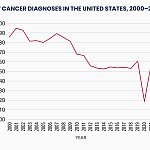
People are living longer than ever before. According to the
Additionally, the number of centenarians—people aged 100 years or more—is expected to reach almost 4 million by 2054.
With people expected to live for longer, there has been a research emphasis on finding ways to ensure they age in a healthy way, with a high quality of life and free of major disease.
“As people live longer, we want to ensure they stay healthy and independent for as long as possible,” Nicola Bondonno, PhD, post-doctoral researcher at the Danish Cancer Institute in Copenhagen, Denmark, told Medical News Today. “Finding natural, everyday ways to support healthy aging, like through diet, offers a low-cost, accessible approach that can have a big impact on quality of life and reduce pressure on healthcare systems.”
Bondonno is the first author of a new study recently published in The American Journal of Clinical Nutrition that found consuming more foods and beverages rich in the phytochemical compound flavonoids may help lower a person’s risk of certain aspects of unhealthy aging, such as frailty and poor mental health.
Flavonoids are found in a variety of fruits, vegetables, and plant-based foods, such as:
“(Flavonoids are) what give many plants their vibrant colors, but they also seem to have health-promoting properties,” Bondonno said. “We focused on flavonoids because our
“Flavonoids have anti-inflammatory and antioxidant properties, which help protect the body’s cells from damage as we age. They also support blood vessel health and may help preserve muscle and brain function. While not all flavonoids work in the same way, many appear to support the body’s systems that tend to decline with age.”
— Nicola Bondonno, PhD
For this study, researchers analyzed health data from more than 62,000 females and more than 23,000 males ages 60 or more who had participated in the Nurses’ Health Study, conducted 1990 to 2014, and Health Professionals Follow-up Study, conducted 2006 to 2018.
Health data included the amount of flavonoid-rich foods and beverages study participants consumed, as well as information on their incident frailty, physical function, and mental health.
At the study’s conclusion, scientists found that female study participants with the highest flavonoid intake had a 15% lower risk of frailty, as well as a 12% lesser chance of impaired physical function.
“These findings suggest that diets rich in flavonoid-containing foods may help older women maintain strength and mobility as they age — key factors in staying independent, avoiding falls, and preserving overall quality of life,” Bondonno explained. “Even modest improvements like these can make a real difference in someone’s ability to live well into older age.”
These same female participants also experienced a 12% lower risk of having poor mental health.
“Women with the highest flavonoid intake had a 12% lower risk of having evidence of mental health concerns such as feeling low, lacking energy, or having depressive symptoms. This finding is important because it shows that what we eat may play a role in supporting not just our physical health, but our emotional and psychological well-being as we age.”
— Nicola Bondonno, PhD
Interestingly, Bondonno and her team did not find that high consumption of flavonoid-rich foods impact male participants in the same way it did female participants.
While male study participants with the highest flavonoid intake experienced a 15% decrease in their risk of poor mental health, there was no benefit when it came to lowering frailty or impaired physical function risks.
“It’s possible that the difference we saw between men and women has more to do with how the study was structured than a true biological difference. The men were followed for a shorter period of time, so we may not have had enough data to detect certain effects. More research is needed to understand whether men and women truly respond differently to flavonoids.”
— Nicola Bondonno, PhD
“Our next steps are to explore the two-way relationship between flavonoids and well-being — looking not only at how flavonoids may support mental health, but also how a person’s well-being might influence their intake of flavonoid-rich foods,” she continued. “We also plan to continue investigating how these foods can be used to support healthy aging and help people live longer, disease-free lives.”
MNT had the opportunity to speak with Manisha Parulekar, MD, FACP, AGSF, CMD, director of the Division of Geriatrics at Hackensack University Medical Center and co-director of the Center for Memory Loss and Brain Health at Hackensack University Medical Center in New Jersey, about this study.
“Flavonoids are potent antioxidants and have anti-inflammatory effects,” Parulekar said. “Oxidative stress and chronic inflammation are considered key drivers of aging and age-related diseases. By potentially slowing down these processes, flavonoids could theoretically slow down negative aspects of aging.”
“Numerous studies have linked flavonoid intake to improved cardiovascular health, including lower blood pressure, improved cholesterol levels, and better endothelial function. Since cardiovascular health is crucial for overall health and longevity, this connection supports the idea of flavonoids promoting healthy aging.”
— Manisha Parulekar, MD, FACP, AGSF, CMD
Parulekar said that lifestyle modifications to improve the aging process through diet offer a proactive, accessible, and potentially transformative approach to promoting healthy longevity for everyone.
“It represents a shift towards preventative healthcare and empowers individuals to take an active role in shaping their own health trajectory,” she continued. “Focusing on diet promotes a more holistic approach to health, addressing the root causes of aging-related decline rather than just treating symptoms. Dietary changes often have positive ripple effects on other aspects of health, such as weight management, energy levels, and mood.”
For readers who would like to add more flavonoids to their diet, we asked Monique Richard, MS, RDN, LDN, a registered dietitian nutritionist and owner of Nutrition-In-Sight, for her top tips.
“Flavonoids, including the six subtypes related to dietary sources — anthocyanidins, flavan-3-ols, flavonols, flavones, flavanones, and isoflavones — have been attributed to protecting cell degradation from oxidative stress and free radicals, as well as being anti-inflammatory due to their concentrated antioxidant levels. They also can act as a chelator (binder) to oxidizing effects of metal ions like zinc, iron, and copper.”
— Monique Richard, MS, RDN, LDN
Richard encouraged readers to consider the numerous foods rich in flavonoids and consider where they may be able to be added throughout the day and week.
“When you think of ‘flavonoids’ think of flavor and see how adding some flare to your daily foods can punch up their benefit and appeal,” she continued. “Also keep in mind the benefit and bioavailability varies by food and per person — keeping the diet diverse and varied is key.”
Richard said a sample diet featuring three servings of flavonol-rich foods a day may look like:





